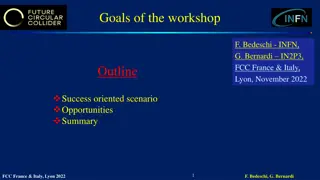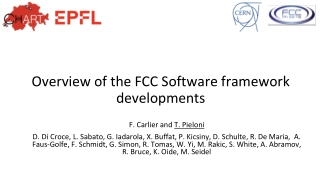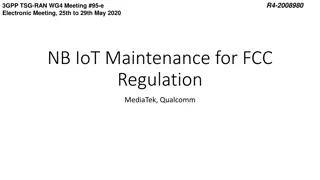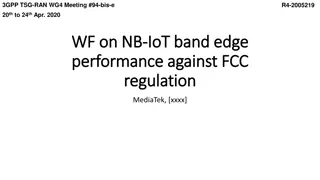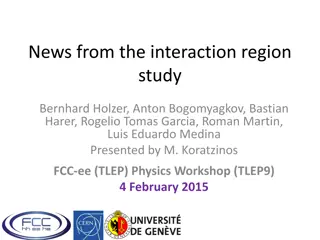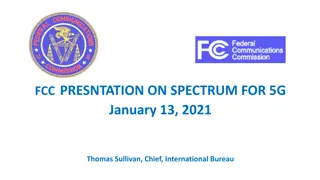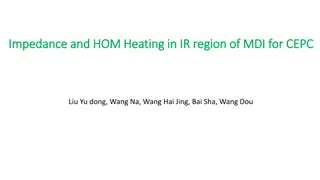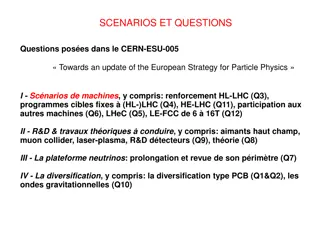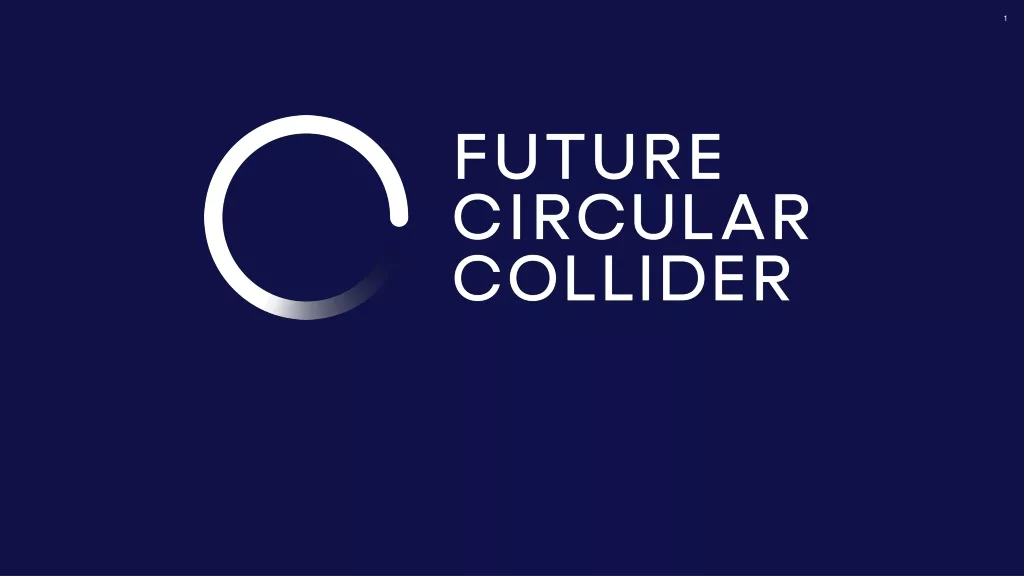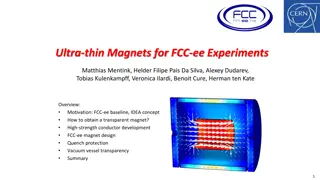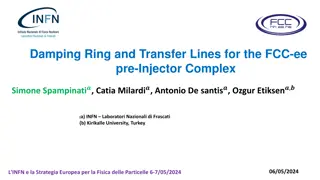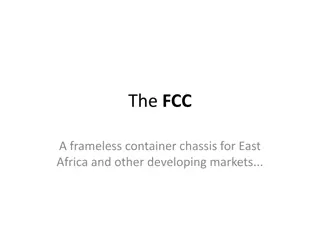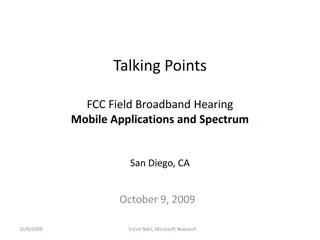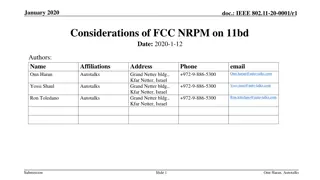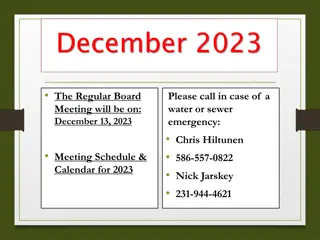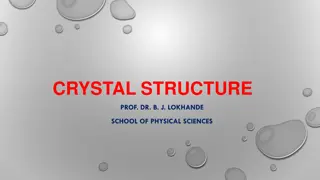FPC & HOM Technology Challenges, FCC
The challenges and technology involved in coupling beam power out of the cavity and coupling RF power into the cavity for the Future Circular Collider (FCC). It also covers the RF layout for the FCC-ee, basic parameters for proton and electron beams, accelerating RF in the LHC, input couplers, and power handling.
Download Presentation

Please find below an Image/Link to download the presentation.
The content on the website is provided AS IS for your information and personal use only. It may not be sold, licensed, or shared on other websites without obtaining consent from the author. Download presentation by click this link. If you encounter any issues during the download, it is possible that the publisher has removed the file from their server.
E N D
Presentation Transcript
FPC & HOM Technology Challenges, FCC R. Calaga, E. Montesinos, S. Zadeh CERN Dec 5, 2023 Ack: I. Karpov, F. Peauguer (CERN), S. Udonwgo (Rostock University)
FPC HOM-C Coupling beam power out of the cavity Coupling RF power into the cavity broadband narrowband Typically coaxial-type or waveguide-type couplers Depending on frequency & power levels, adapted couplers are chosen For the Future Circular Collider, up to 1 MW input and 10 s kW output is expected
FCC-ee RF Layout 90 km two ring synchroton for ?+? collisions between 100 MV 11 GV per turn using 400 or 800 MHz SRF systems Total beam power 50 MW (x2) Full energy booster for top up injection
Basic Parameters protons electrons ? ? HL-LHC Z W H Energy [GeV] 7000 45.6 80 120 182.5 Beam current [mA] 1100 1279 137 26.7 4.9 RF Voltage [MV] 12-16 79 1000 2080 2100/9380 # Cavities 16 112 264 264 264/448 RF Power [kW] 300 900 388 382 75/177 Full energy booster not shown in the table
LHC Accelerating RF - Today 8 cavities (2 CM) per beam Cavity voltage = 2 MV (max) Beam current = 1.1 A Input power = 300 kW (max) HOM power < 1 kW (max)
LHC RF Input Coupler 300 kW-CW air cooled coaxial scheme Cylindrical window for waveguide transition with matching, no door-knob 75 coaxial line to push multipacting to higher power levels + DC bias Remotely controlled variable couplers to change ??by factor 3-5 in operation
Input Power, FCC Power vs Input Coupling A single RF scheme is not practical to satisfy high current and high energy Power range of factor 5 & Coupling range (??) of factor 500 Z Present baseline 3 RF systems with fixed coupling, reasonable approach W, H ttbar No movable coupler is a big simplification, a movable short on air-side is being studied to adjust coupling if needed
Power Handling (empirical scaling) Experience with power couplers built at CERN since 2000 used define an empirical scaling future The FCC specification in some scenarios is requiring the power levels to about factor 2 larger present Not obvious in CW mode to increment by factor 2 w/o considering novel cooling techniques, prevent multipacting damage and arcing
Coupler Towards FCC During the high gradient R&D program a MW class air-cooled coaxial-window coupler was developed for pulsed operation This concept is used as the present baseline for the FCC. The jump to CW needs to be demonstrated, the critical point will be the RF window An alternate disk-window outside the cryomodule is simpler option, but requires re-thinking the clean assembly of such a configuration R&D on higher purity ceramic (99.5%) is ongoing
Ceramic Windows Types, CERN Disk windows SPS, 800 MHz 150 KW CW Cylindrical windows LHC, 400 MHz 500 kW CW Coaxial windows HL-LHC Crab, 400 MHz 100 KW CW
Multipacting SEY of ceramic window very high and prone to multipacting & risk to ceramic Improved with Ti coating on the vacuum side. Also helps to remove electrostatic discharge. Process well mastered R&D ongoing to study low SEY ceramic. Potential simplification pending validation & cost DC bias (2-5 kV) is necessary to suppress multipacting but brings additional complications. Magnetic means of suppression under study but not necessarily compatible with SRF
Thermal Management Outer line: a thin Stainless Steel tube, acting as the thermal insulator to separate between the 2K and the 300K with He-gas flow or thermal intercepts Outer-line: Stainless Steel + gold + copper A thin layer (~ m) of copper, to minimize RF losses, not transmitting so well the thermal losses to the cryogenic system Air-cooling Peel off due to rinsing With the recent HL-Crab 1.5 mm Stainless Steel tube + Gold 2 m (flash) + Copper (or gold ) sputtering layer 10 m being pursued as standard procedure Inner line: Massive OFE copper with air cooling avoid issues with freezing water at brazed joints
Test Box & Conditioning Example of LHC RF conditioning system High power RF (pre)-conditioning of a clean coupler is necessary for controlled desorption of gases from the RF surface in SW & TW conditions This process is time consuming and there is no short-cuts especially with CW power levels considered (200 kW to 1 MW) Almost 1000 couplers to process for the main ring and ~500 couplers for the booster
Assembly into Cavity 1990 s One of the most delicate & critical step, likely define the maximum field reach and onset of field emission. IS04 like clean room assembly makes it very cumbersome For the HL-LHC crab cavity project, special 3D printed tooling and semi-robotic assembly proved to minimize the risk Moderate gradients required for FCC, the assembly procedure needs to some re- thinking 2017
Cryomodule Integration Cryomodules are typically conceived with cavities in mind For very high RF power like the LHC & FCC, the power coupler and HOMC are a significant part of the cavity assembly . They also determine the performance reach Minimal distance for compact cryomodule Present concept of installing the couplers in clean room and integration into cryomodule after may not be optimum Can we install the couplers after the cryostating in a clean way ? Coupler exchange w/o de- cryostating and robotic way
Higher Order Mode Couplers (HOMC)
Impedance & HOMs Three main issues to be addressed for the FCC 1. Strong feedback around the fundamental mode 2. Strong damping of the low frequency HOMs for CBI 3. Efficient extraction of kWs of HOM power Fundamental mode impedance ???? = -4 stability opt detuning (~4 ?rev) PRSTAB 21, 071001 (2018)
LHC RF - HOM Scheme The LHC system uses two coaxial type HOM couplers, narrow-band (low frequency) & broadband (> 700 MHz) Look inside cryomodule The large beam pipe aperture (300mm) is key for achieving very strong damping Broadband Narrowband
HOM Couplers, FCC Three types of tuned coaxial couplers studied for strong damping targeting low frequency modes. Non-trivial geometries & tolerances DQW HOM Coupler LHC Hook-type The tuning is very cavity specific, a universal coupler cannot be adopted as yet LHC Probe-type Example of transmission curves for 801.58 MHz
HOMC Design Considerations DQW coupler, HL-crabs For CW operation, the simulations and experimental experience with LHC and HL-LHC indicate 1. Demountable coupler with careful thermal design (gasket & feedthrough location) 2. Active cooling with a dedicated He-jacket 3. Sub-mm tolerances cost driver 4. Cold RF window remains a big concern He channel As we approach kW level powers, we are exploring RF conditioning with a dedicated test-box Trials with Nb-coating on Cu HOM couplers can open up a cheaper avenue, R&D started He-Jacket
FCC HOM Couplers, 400 MHz 2-Hook type couplers/cav Even with 1-2 cells & large aperture, stability requirements demand extremely strong damping A cavity shape improvement from the LHC & extensive damping studies allowed to reduce to single Hook type coupler important accomplishment! 224 528
FCC HOM Couplers, 800 MHz For 5-cell cavities at 800 MHz, exhaustive studies on cavity design & HOM configuration to reach the damping requirements with a two crab cavity type coaxial coupler Three important lessons from crab cavity program 1. Tight tolerances led to machining from Nb-bulk 2. Careful surface treatment of the Niobium surface similar to the SRF cavities (non-trivial) & active cooling 3. Cold-to-warm transitions to transport the wideband HOM power is a challenge Longitudinal modes Low freq transverse modes at the H-limit
High Power The very short bunches and high currents, the level of HOM power (CW) is 10 s of kW for the Z & up to 1 kW for the ttbar The HOM power extracted with and w/o collisions can vary by several factors due to bunch length For non-resonant excitation, the is not a strong dependence on bunch/train spacing for modes above cut-off Dangerous Safe HOM 5 ??? For resonant excitation, some filling schemes are forbidden Cut-off: 765 MHz
HOM Damping, Cryomodule It was already studied since the 90 s (LHC) that the behavior of HOM damping is different in a cryomodule w.r.t a scheme optimized on a single cavity. Especially true when cavity-cavity coupling is strong due to large apertures For FCC, inter-cavity damping and extraction of HOM power is essential. This requires accurate knowledge of power distribution in a CM and not just a single cavity
Inter-Cavity Damping, 400 MHz A 2-coax solution was found to be a simple an efficient solution for damping inter-cavity trapped modes & extraction of power above cut-off The distribution of power (total = 40 kW) to allow for uniform output at the level of 10% look reasonable The huge power extraction and broad-band in nature poses several technical challenges similar to FPC and complications for CM integration
Inter-Cavity Damping, 800 MHz A single coaxial couplers for efficient damping inter-cavity trapped modes & extraction of power above cut-off. A waveguide solution was studied but more complex to implement Similar to 400 MHz, approx. 10% of power extraction through these couplers Some design features to capture both longitudinal and transverse modes to capture different polarizations t t: ?HOM tot 2.98 kW 0.06 kW 0.28 kW 0.31 kW 0.28 kW 0.05 kW 0.78 kW 0.05 kW 0.06 kW 0.07 kW 0.07 kW 0.08 kW 0.06 kW 0.07 kW 0.73 kW 0.03 kW
Taper or not to Taper Taper length Taper small diameter 300 mm For practical reasons, it is necessary to reduce the aperture a long taper For the FCC, the broadband part of the HOM spectrum is major contributor to HOM power A taper-less cryomodule is preferable but may not be practical at 300 mm aperture Optimum inter-cryomodule transitions with or w/o use of ferrite materials will be a challenge
RF Feedthroughs for HOMs HL-LHC series 1st prototype The kW level CW power extraction through the HOM feedthrough is real challenge (much like an FPC) With HL-LHC a substantial focus and R&D was done to develop a high-power feedthrough also taking into account transport of cryomodules (25 ) There is R&D necessary to master the bonding process of ceramic to Copper and manage stress to make a robust RF feedthrough that can handle high power in SRF environment 20cm drop test 10cm drop test
RF Lines for HOMs The kWs of power needs to be extracted from the couplers to an appropriate RF load in vacuum HOM coupler feedthrough 2K A important development during the crab cavity project at CERN led to the development of semi-rigid lines to handle ~5 kW Flexible contacts Stainless Steel lines with 5 m copper coating including ceramics for thermal anchor. Special RF fingers & thermal intercepts for to account for thermal cycles Ceramic for thermal anchor 80 K Experience shows that these are not trivial & expensive. Mass production for FCC will be a major challenge
Transport Elaborate simulations to design supporting frame and transport restraints to minimize the stress during transport (cavities, cryomodules & components) Logistics to apply this on large number of cryomodules is not trivial Active shock logging, accelerator meters
Final Thoughts The FCC requires power couplers (0.2-1 MW level) & many HOM couplers operating at several kW s level Efficient power management, RF windows for high power CW operation & transport of couplers will remain the main challenges The physics timescale proposed for the FCC-ee is very challenging (< 5yrs/working point)
Some References FPC https://www.google.com/url?sa=t&rct=j&q=&esrc=s&source=web&cd=&cad=rja&uact=8&ved=2ahUKEwjCpNOB2fiC AxXSDOwKHZoYA1sQFnoECBIQAQ&url=https%3A%2F%2Findico.frib.msu.edu%2Fevent%2F38%2Fattachments%2F159 %2F1270%2F20210624_SRF_tutorial_FPC_Eric_Montesinos.pdf&usg=AOvVaw17yghM7w82RMroy5EBoLsr&opi=8997 8449 HOMC https://indico.cern.ch/event/1202105/contributions/5391663/attachments/2661531/4610909/1-cell%20and%202- cell%20400%20MHz%20cavity%20RF%20designs%20for%20FCC-ee.pdf https://indico.cern.ch/event/1280043/
Ceramic Window Most sensitive part of an FPC & separates the beam vacuum to atmosphere through which very high-power RF has to be transmitted Any leak on the window immediately leads into degradation of the cavity and nearby elements of the machine It is commonly a ceramic brazed with metal (after metallization Mo-Mg deposition) CERN specification report (Al2O3 - 97.5 %): http://cds.cern.ch/record/91419?ln=fr R&D towards 99.5% spec is under study
The SWELL cavity, 600 MHz Elliptical cavity with radial slots and coaxial couplers for strong HOM damping A 2-cell design at 600 MHz scenario to be use across the FCC energy regime was proposed to have a single frequency and single cavity type. It is however not beig actively pursued due to beam dynamics issues at 600 MHz for the lowest energy A prototype at 1.3 GHz is under study for validation to understand the SRF limitations with a complex interface
Use of Beam Pipe Absorbers Beam pipe absorbers given their broadband damping nature has been exploited in various accelerators. Both 300 K and 77 K absorbers have been studied in great detail The use for FCC is not obvious and not studied in much detail. Some R&D is required to push the usage of BLA s in a more robust way than it is done today Cornell beam line absorber (77K) XFEL beam line absorber (77K) CESR beam line absorber (300K)
HOMs of the 800 MHz 5-cell cavity 2DQW couplers ?tot= 0.6?3 ?ext= 0.7?3 ?tot= 1.6?4 ?tot= 5.9?4 ?ext= 2.0?7 ?tot= 0.8?3 ?ext= 1.0?5 ?tot= 5.8?3 ?ext= 6.3?4 ?tot= 4.4?3 ?ext= 5.2?7 Some dangerous HOMs above BP cutoff weakly couple to HOM couplers their Q-factor dominated by power propagating out through BPs It's not enough to examine the HOMs of a single cavity the impedance in a cavity string considered must be 1/?tot= 1/?ext+ 1/?rad ?ext corresponds to the power propagating through HOM couplers ?rad correspond to radiated power through beam pipes


